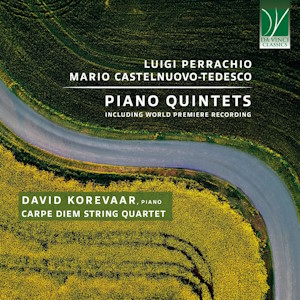
Luigi Perrachio (1883-1966)
Quintet for 2 violins, viola, cello and piano (1919)
Mario Castelnuovo-Tedesco (1895-1968)
Quintet No.1 for 2 violins, viola, cello and piano (1932)
David Korevaar (piano)
Carpe Diem String Quartet
rec. 2023, Grusin Music Hall, University of Colorado, Boulder, USA
Da Vinci Classics C00796 [60]
Luigi Perrachio and his more famous countryman Mario Castelnuovo-Tedesco were born into a time when Italian music was beginning to escape the idea of vocal music only here please! Both composers were prolific in their output with the majority of their writing in the fields of instrumental, chamber and orchestral music, especially Castelnuovo-Tedesco. Perrachio has fallen by the wayside somewhat partly due to his spending pretty much all of his life in his home town of Turin but also because he published very little. Indeed the piano quintet heard here existed only in manuscript, held in the library of the Turin Conservatory, until David Korevaar arranged for it to be published by DaVinci Press in 2022.
After a disagreement with his teacher at the Turin Conservatory Luigi Perrachio was largely self-taught, taking much of his inspiration from the music of Debussy and Ravel. As a pianist he studied for a time with Ignaz Brüll in Vienna but must have had a innate gift for the instrument and, as with Spanish pianist Ricardo Viñes who he made the acquaintance of in Paris, he championed modern Italian composers.
His piano quintet dates from 1919. It opens in a rather tortured mood, the piano laying relentless waves of arpeggio figuration down while the strings play the rather stark and abrupt first theme unison. The parts begin to intermingle until it is the strings who have the tempestuous figuration and soon after the piano introduces the sparse second theme. In this relatively long movement with an extended development section there is sense of restlessness that pervades much of the writing, even in its more lyrical moments and this continues into the darkly playful scherzo whose theme is divided up between the parts like some impish game of catch. It ends with a unison series of unconnected notes – almost a twelve-tone row as Korevaar points out in his notes – and a reference to the fate motif from Beethoven’s C minor symphony before being firmly but enigmatically ended by the piano. The slow movement is a balm to the anguish heard earlier and the piano’s humorously tinkling bell-like version of the fate motif suggests that this is where we should be, in this reflective mood, laughing at the fate that tosses us about, all unwilling. Perhaps this realisation is why the finale sets off in such light-hearted style, a moto perpetuo whose angular themes are full of rhythmic vitality. The second theme is similarly easy-going, a simple melody over a trilling accompaniment. Some stern and foreboding music tries to intrude on the general mood of optimism but it is summarily dismissed before the bright ending.
Having mentioned an almost twelve-tone row it is important to state that this is a very tonal work in a late romantic style and this is evident even more in the first quintet by Castelnuovo-Tedesco written some 13 years later. Mario Castelnuovo-Tedesco was more cosmopolitan than Perrachio, partly by choice and partly by circumstance; Mussolini’s anti-Jewish laws drove him out of the country and he settled in the United States where his already vast compositional output was expanded with many film scores. It is notable that names like John Williams, Jerry Goldsmith and Henry Mancini appear among his students. The first quintet opens with the strings in chorale mode giving way to some exotic sounding figuration in the piano; this leads into the movement proper, warm hearted and pastorale, eschewing the angst of Perrachio’s quintet. Castelnuovo-Tedesco also displays more variety of timbre and interplay between the instruments: along the way the theme is accompanied by a fanfare like motif one moment and ghostly harmonics the next. The lilting second movement is wonderfully passionate, its main theme made that tiny bit spicy with the introduction of just one piquant note; the reason I mentioned Castelnuovo-Tedesco’s film music was because the heart-on-sleeve treatment of the theme here has a certain cinematic feel, hinting at what was to come. The scherzo trips along energetically with a curious mix of drama and almost carefree dance, especially so at the end where portentous octaves and chords give way to a delicate and comic pizzicato ending. In a reversal of Perrachio’s quintet Castelnuovo-Tedesco is tempestuous and restless in the finale, anguish in the writing for all instruments and with a second theme whose augmented intervals hint at his Jewish heritage and still manage to add to the unsettled mood. Toward the end the piano sets up a funeral march while the strings sing in counterpoint above though the end when it arrives is suddenly bright and optimistic.
David Korevaar and the Carpe Diem String Quartet play with passion and zest. The recording is warm and full if not as bright as the cpo recording of the two Castelnuovo-Tedesco piano quintets with Massimo Giuseppe Bianchi and the Aron Quartet (cpo 777961 review); I prefer the sound of the current recording which seems to suit the style of the piece more and allows the fine detail of the gorgeous instrumentation to shine through. Korevaar is to be applauded for bringing the Perrachio quintet into the limelight and it makes a fine companion to the sunnier Castelnuovo-Tedesco.
Rob Challinor
Buying this recording via a link below generates revenue for MWI, which helps the site remain free.



















